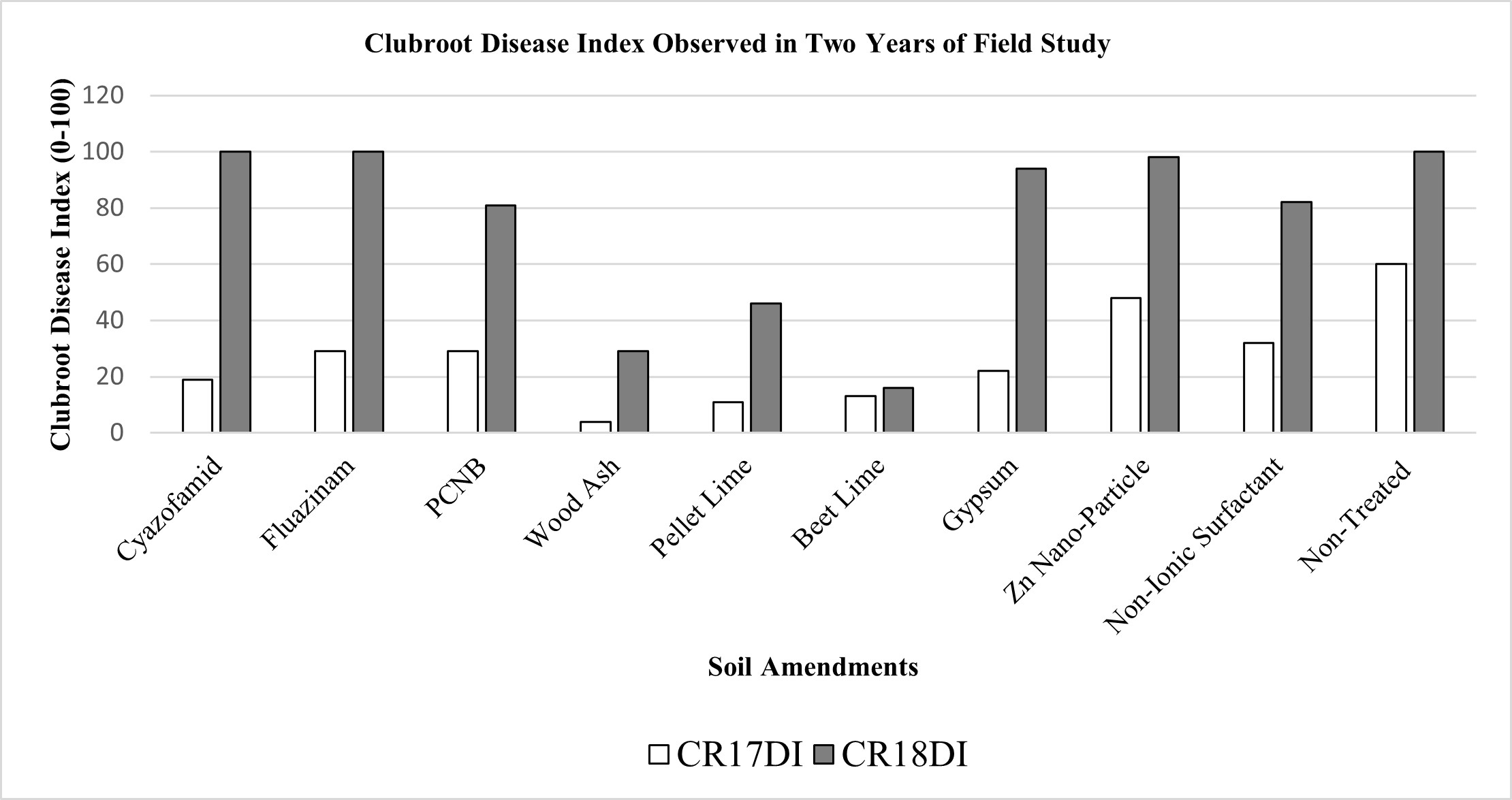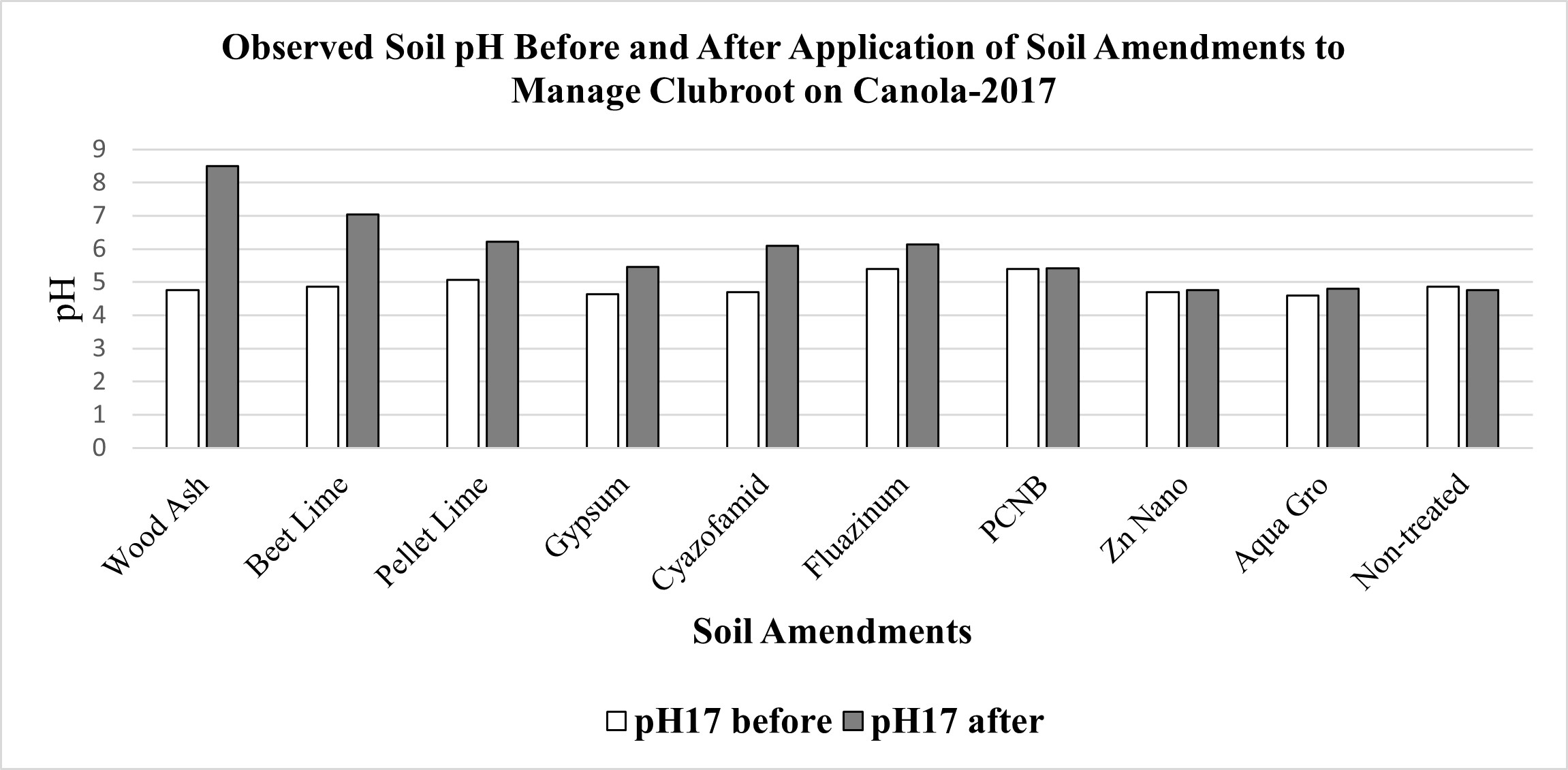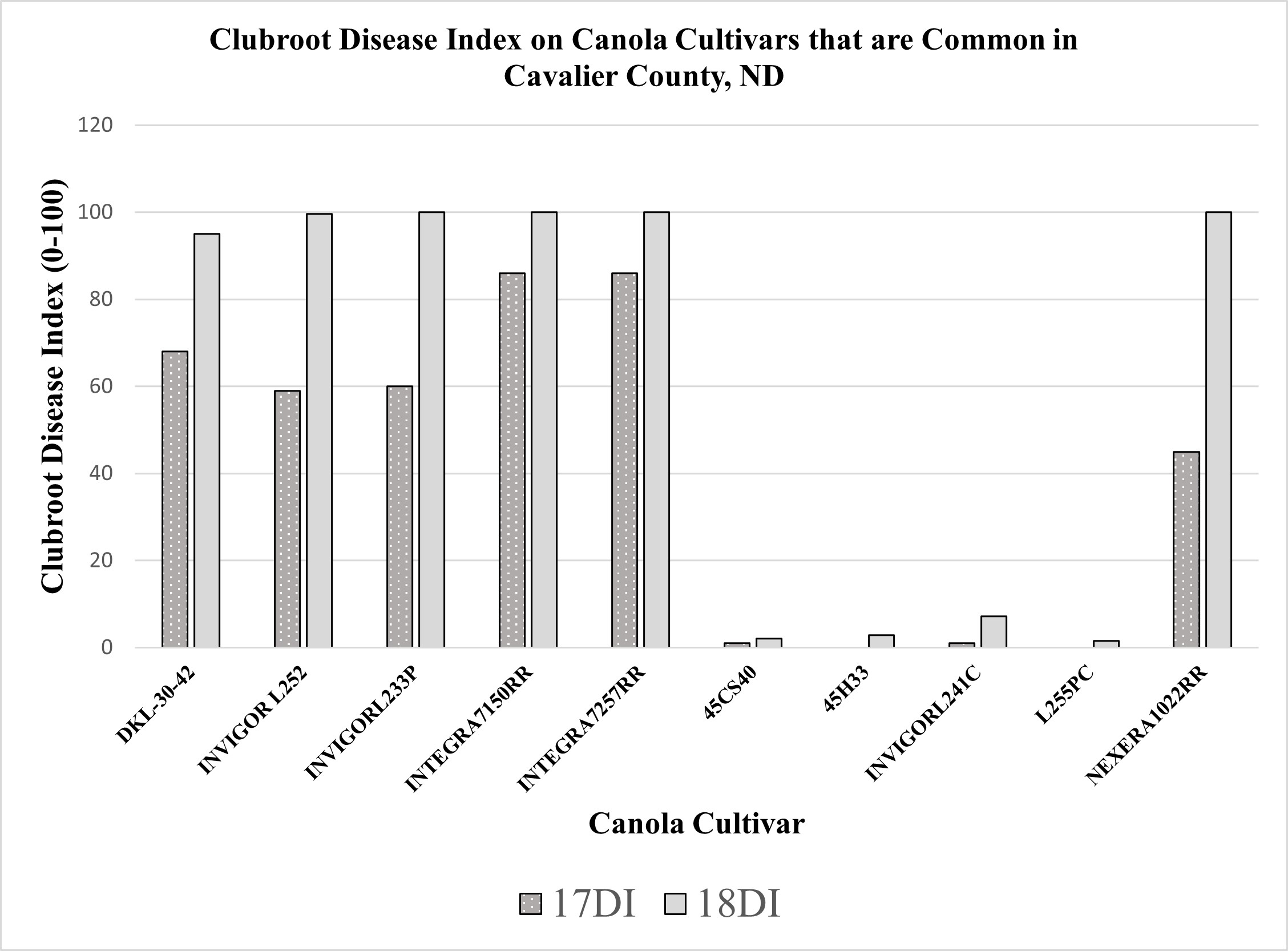Objective 1: To evaluate the effects of adding fungicides and pH-altering soil amendments to soil to manage clubroot on canola in field conditions.
Nine treatments consisting of fungicides and various compounds (Table 1) that can alter pH of soil were amended to soil and were compared with the non-treated check to evaluate their efficacy against clubroot pathogen under field conditions.
Treatments of wood ash, pellet lime, beet lime and gypsum were applied seven days before planting into the soil at a depth of three to four inches and thoroughly mixed in the soil with a rototiller.
Whereas, the rest of the treatments were drenched just before planting into the soil at a depth of three to four inches and were mixed thoroughly in the soil with a rototiller.
Table 1: List of products that were amended in the soil to manage clubroot on canola.
Product | Trade name | | Dosage | | | | |
|---|
Cyazofamid | Ranman | | 7.5 l/ha | | | | |
Fluazinam | Allegro | | 2000 g/ha | | | | |
PCNB | Blocker | | 67.5 kg/ha | | |
Wood ash | Fly Ash | | 7.5 t/ha | | | | |
Calcium Carbonate | Pellet Lime | | 7.5 t/ha | | | | |
Beet lime | Versa Lime | | 15 t/ha | | | | |
Gypsum | Gypsum | | 7.5 t/ha | | | | |
Nano-Particle | Zn | | 500 mg Zn | | | | |
Non-Ionic surfactant | Aqua-Gro 2000 | | 10 g/m just before planting incorporated into rows |
Non-treated | Check | | Non-Treated Control | | | | |
Variety: DKL 30-42 RR
Plot Size: 3 ft. x 5ft.
Planted: First week of June (Hand planted after thorough tillage with a rototiller.)
Field Design: Randomized complete block design (RCBD) with four replications.
Clubroot Evaluated: End of July in both years, 2017 and 2018.
Rating scale used: Clubroot rating scale: 0 = no galling, 1 = a few small galls (small galls on less than 1/3 of roots), 2 = moderate galling (small to medium-sized galls on 1/3 to 2/3 of roots), 3 = severe galling (medium to large-sized galls on more than 2/3 of roots) (S.E. Strelkov). A Clubroot Disease Index (CRDI) has been calculated using the incidence and severity data of clubroot obtained.
Figure 1: Efficacy of soil amendments to manage clubroot incidence in field conditions.
Figure 2: Soil pH before and after application of soil amendments to manage clubroot on canola in 2017.
Figure 3: Soil pH before and after application of soil amendments to manage clubroot on canola in 2018.
Results and Conclusions: Significant differences in clubroot disease severity index (DSI) (Figure 1: CR17DI and CR18DI) were observed in the treatment of beet lime followed by wood ash and calcium carbonate compared to the other treatments tested in both years of current research. However, results of wood ash are not recommended for use in grower fields in consideration of poor seedling emergence and plant population (data not shown). Results of wood ash require further testing at lower dosages. In general, emergence and growth of many crops are negatively affected with increase in basic pH. This could be one reason for low emergence in wood ash treated plots. Lower clubroot disease severity index (CRDSI) was observed in respective treatments due to alteration in pH on log scale by 1.5 to 3 points in the treated plots on application of beet lime, wood ash and pellet lime. Based on two years of clubroot disease data using beet lime at 15 t/ha proved to be a viable option to manage clubroot. However, growers should keep in mind the cost, practical feasibility of using beet lime at high dosage and the extent of ease in application over larger areas in the field. If clubroot has been observed only in few isolated spots in the field, beet lime would work effectively in managing the disease for that particular year of application. In current research, there were significant differences in CR18DSI versus CR17DSI, which can be attributed to the soil population of viable resting spores of clubroot pathogen in the research ground. In general, continuous exposure of canola or other brassica crops year after year on the same research ground adds billions of spores to that ground. This might have resulted in higher DSI in the treatments tested in 2018.
Objective 2: To evaluate the symptoms caused by clubroot pathogen on various hosts of brassica family in field conditions.
Cruciferous host plants: Eleven host plants from brassica (cruciferous) family were planted in both years of this research.
Plot Size: 3 ft. x 5ft.
Planted: First week of June (Hand planted after thorough tillage with a rototiller.)
Field Design: Randomized complete block design (RCBD) with four replications.
Clubroot Evaluated: Last week of July.
Figure 4: Clubroot Disease Index (CRDI) on various cruciferous hosts.
Results: Out of the 11 cruciferous hosts planted, only seeds of shepherd’s purse did not germinate. The remaining 10 host plants showed positive response to clubroot infection with high clubroot disease index (CRDI). Rutabaga and radish white were only tested in 2018. The brassica family crops that were planted (including weeds or volunteers) in clubroot infected fields added additional amounts of inoculum to the soil that resulted in more clubroot infections in this year’s trial.
Objective 3: To evaluate the resistance potential of commercial canola cultivars against clubroot pathogen in field conditions.
Plot Size: 3 ft. x 5ft.
Canola Varieties: Ten commonly cultivated canola varieties were planted to determine the level of resistance against clubroot (Table 2).
Table 2: Commonly cultivated canola varieties in Cavalier County.
| | Clubroot |
|---|
No. | Cultivar | Response |
1 | DKL 30-42 | Susceptible |
2 | InVigor L252 | Susceptible |
3 | InVigor L233P | Susceptible |
4 | Integra 7150RR | Susceptible |
5 | Integra 7257RR | Susceptible |
6 | 45CS40 | CR |
7 | 45H33 | CR |
8 | InVigor L241C | CR |
9 | L255P | CR |
10 | Nexera 1022RR | Susceptible |
Note: CR=Clubroot Resistant
Planted: First week of June (Hand planted after thorough tillage with a rototiller.)
Field Design: Randomized complete block design (RCBD) with four replications.
Clubroot Evaluated: Last week of July.
Clubroot Disease Index (CRDI):
CRDI: <30% of Susceptible Check = Resistant (R)
CRDI 30-69% = Intermediate (I)
CRDI >70% = Susceptible (S)
Note: To validate a clubroot research trial, the susceptible check should have > 60% of Disease Index.
Figure 5: Mean clubroot incidence (%) on various commercial cultivars of canola.
Results: Canola cultivars InVigor L255PC, 45H33, 45CS40 and InVigor L241C showed resistance to clubroot and were significantly different from the other varieties tested. The added population of brassica crops that were grown last year explains the difference in the Clubroot Disease Index between years.
Future Research: The addition of commercial cultivars to this list will be very helpful to the growers.
Case Study: Clubroot incidence observed in a field that has not been exposed to brassica crops including canola for the past five years.
Objective: To test the presence of clubroot pathogen in the soil and its infection potential in soil where canola has not been grown for five years.
Methodology: A field with clubroot on canola identified in 2013 was used. Soil samples were collected before planting and at 56 days after planting canola varieties. Three canola varieties (one clubroot resistant, InVigor L255PC, and two clubroot susceptible varieties, DKL 30-42 and Nexera 1022R) were hand planted in plots of 3 ft. x 5 ft. dimensions and replicated four times in a randomized complete block design.
Varieties were evaluated 56 days after planting for their incidence and severity of clubroot. Based on incidence and severity data a Clubroot Disease Index was calculated.
Results: Soil samples at planting were molecularly tested by Dr. Chittem (Post-Doctoral Associate with Dr. del Rio, NDSU Department of Plant Pathology) for presence of clubroot pathogen in the soil. A faint band has been observed in the molecular analysis. Similar results have been obtained in field evaluation of Clubroot Disease Index on all three varieties evaluated (Figure 6). Data indicates the presence of low levels of clubroot pathogen and resting spore infection potential even after five years without canola. Likewise, this data supports the recommendation of a five-year crop rotation practice in clubroot-infected fields.
Figure 6: Clubroot disease index observed on three varieties planted after five years of clubroot confirmation.
Note: Currently waiting on clubroot resting spore population per gram of soil results from Dr. Chittem, which will aid in grower decision to grow clubroot resistant varieties.
Acknowledgements: The author acknowledges funding support from the Northern Canola Growers Association.
Barry Coleman and the NCGA Board Members
Amanda Arens, LREC Research Specialist
Canola growers in Cavalier County who offered their land for research and who supplied the commercial seed varieties.
Greg Engel, Wilbur-Ellis
Dave Nowatzki, Pioneer
Wilbur-Ellis
Jon Vanderberg, Bayer
Simplot, Langdon, ND
Dr. Brian Jenks, NCREC Weed Scientist
Jordan Ullyott, Nester Majait, and Justina Klindt, LREC Seasonal Employees
Industry personnel who supplied the chemicals.
Anitha Chirumamilla, Cavalier County Ag Extension Agent (Assisted with evaluation and photography.)
Kishore Chittem, Post doc of Dr. del Rio, Department of Plant Pathology, NDSU Fargo (Confirmed clubroot positives molecularly.)






